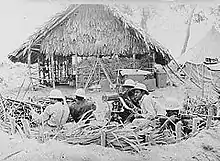Liberia in World War II
Liberia did not become militarily involved in World War II until January 1944, with the election of William Tubman, at which time the country declared war on Germany and Japan. However, even before the start of Liberia's official military involvement, the nation participated in the war for two years under the terms of a Defense Agreement with the United States. Apart from Ceylon (present day Sri Lanka) and the Belgian Congo, Liberia possessed one of the few remaining sources of rubber for the Allies. To guarantee a steady supply of rubber from the world's largest rubber plantation, operated at Harbel by the Firestone Company since 1926, the US government built roads throughout the country, created an international airport (known as Robertsfield Airport), and transformed the capital, Monrovia, by building a deep water port (the Freeport of Monrovia).

U.S. Army Forces in Liberia, which established its headquarters in mid-1942, was to provide services along the ATC route through Liberia, defend the U.S. Army installations as well as the facilities of the Firestone Tire and Rubber Co. plantation, and carry out certain diplomatic commitments for training Liberian military forces and for the construction of roads.[1] The presence of a force of about 2,000 men in Liberia in this early period had the added advantage of posing some threat to the pro-Vichy French around Dakar and in French Guinea and the Ivory Coast. [end p67]
Medical activities in Liberia were administered at the station surgeons office at Roberts Field, some thirty miles east of Monrovia, where central control over medical matters was maintained and medical reports on the Liberian force were completed. The 25th Station Hospital (250 beds) near the field cared for the medical needs of the entire command. From June 1942 until April 1943, Lt. Col. (later Col.) Loren D. Moore served as station surgeon. Under the experienced direction of Lt. Col. (later Col.) Justin M. Andrews, Colonel Moore carried out extensive malaria survey and control work. When the entire Liberian Task Force, commanded by Brig. Gen. Percy L. Sadler, arrived in the spring of 1943, both Moore and Andrews were transferred to the new North African theater. Lt. Col. Stephen D. Berardinelli, commanding officer of the 25th Station Hospital, succeeded Moore as station surgeon. Medical department personnel in Liberia were responsible for the medical care of a large force of construction engineers during the period when the base was being built, and later gave support to all elements of the defense forces in Liberia. Air Transport Command personnel, some members of the Royal Air Force, and natives working for the Army also received medical care. In September 1943, the Liberian command was subordinated to the Middle East theater, but this action did not change its basic mission. [p68]
In 1943, the deployment of the 25th Station Hospital represented the first African American medical unit to be sent overseas, to Liberia.[2]
In 1944, with its entry into the war, Liberia adopted the US dollar and became one of only four countries in Africa to join the newly formed United Nations.
The Africa-Middle East Theater of Operations was established on March 1, 1945, was mainly concerned with the liquidation of the Army's property holdings and other interests in Africa, Palestine, and the Persian Gulf area. The North African installations of the Mediterranean Theater and its base commands at Casablanca were transferred to the new Theater in March 1945; the United States Army Forces in Liberia were transferred to it in April 1945.[3] The United States Army Forces in Liberia were subsequently under the North African Service Command, which was the former Mediterranean Base Section, at Casablanca. By 1946 all [the Town Commands] except the agency at Casablanca were discontinued.
See also
References
- Charles M. Wiltse (1965). UNITED STATES ARMY IN WORLD WAR II: The Technical Services: THE MEDICAL DEPARTMENT: MEDICAL SERVICE IN THE MEDITERRANEAN AND MINOR THEATERS. WASHINGTON, D.C.: OFFICE OF THE CHIEF OF MILITARY HISTORY, DEPARTMENT OF THE ARMY. pp. 67–68.
- Bellafaire, Judith (1993). The Army Nurse Corps: A Commemoration of World War II Service. U.S. Army Center of Military History. pp. 8–9.
- https://www.ibiblio.org/hyperwar/ATO/FRWW2-II/FRWW2-4.html
- Sherman, Frank. Liberia: The Land, Its People, History and Culture. Intercontinental Books, 2010.
- Charles M. Wiltse (1965). UNITED STATES ARMY IN WORLD WAR II: The Technical Services: THE MEDICAL DEPARTMENT: MEDICAL SERVICE IN THE MEDITERRANEAN AND MINOR THEATERS. WASHINGTON, D.C.: OFFICE OF THE CHIEF OF MILITARY HISTORY, DEPARTMENT OF THE ARMY.